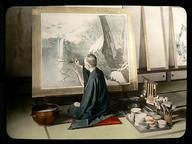Quiz Answer Key and Fun Facts
1. This art term, describing an outlined image of a solid figure and having the appearance of a 'shadow', was named for a finance minister in the government of French King Louis XV. What is the name of this shadowy art form?
2. Mantegna was a specialist in this illusionistic style, which involves paintings on ceilings that are so foreshortened as to appear suspended in space, floating above the onlooker's head. Name the technique.
3. What was the name of the art exhibition held in 1863 in Paris upon the orders of Napoleon III wherein Manet's 'Déjeuner Sur l'Herbe' was first exhibited to the public?
4. Louise Moillon, Jean-Baptiste-Simeon Chardin , and Paul Cézanne were all considered the greatest painters of what genre in France in their respective centuries?
5. Leonardo da Vinci specialized in this technique, which entails blending of tones in colors in such a way that sharply defined boundaries are imperceptible in a painting. What is this technique called?
6. The term 'Sezession' applies to a group of painters in Germany and Austria who, rebelling against the stultifying atmospheres of the official academies, adopted their own avant-garde exhibitions. Who was the first president of the Vienna Sezession?
7. A creamy dilution of clay, water and possibly pigments, it is used to decorate earthenware. What is being described here?
8. 'Stabile' is the charming term used by French Dada artist Jean Arp in 1932 to describe the sculptures of which of his admired colleagues?
9. In an ancient Greek or Roman temple, the columns were built upon a masonry platform called...?
10. I will be gentle with the final question and ask a rather easy question! With which 20th century art movement were Salvador Dali, René Magritte and André Breton associated?
Source: Author
thejazzkickazz
This quiz was reviewed by our editing team before going online.
Any errors found in FunTrivia content are routinely corrected through our feedback system.

